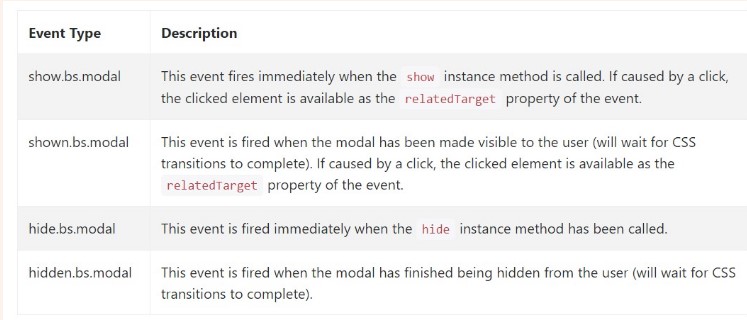Bootstrap Modal Popup Jquery
Introduction
Oftentimes, when ever we build our pages there is such web content we do not wish to happen on them up until it is definitely really wanted by the site visitors and once such time occurs they should have the ability to simply just take a automatic and basic activity and obtain the required info in a matter of minutes-- swiftly, convenient and on any type of display screen dimension. When this is the scenario the HTML5 has simply just the perfect element-- the modal. ( get more information)
Critical things to consider:
Before getting started with Bootstrap's modal component, make sure to review the following as Bootstrap menu decisions have already reformed.
- Modals are developed with HTML, CSS, and JavaScript. They are actually placed over everything else inside of the document and remove scroll from the
<body>- Clicking on the modal "backdrop" will immediately close the modal.
- Bootstrap only supports one modal window at once. Embedded modals aren't maintained while we think them to remain weak user experiences.
- Modals application
position:fixeda.modal- One once again , due to
position: fixed- In conclusion, the
autofocusContinue viewing for demos and application guidelines.
- As a result of how HTML5 identifies its own semantics, the autofocus HTML attribute provides no effect in Bootstrap Modal Popup Position. To get the identical result, work with certain custom made JavaScript:
$('#myModal').on('shown.bs.modal', function ()
$('#myInput').focus()
)How to apply the Bootstrap Modal Popup Set:
Modals are totally sustained in recent 4th version of one of the most prominent responsive framework-- Bootstrap and can as well be designated to exhibit in a variety of sizes according to designer's wishes and visual sense yet we'll go to this in just a minute. First let us discover tips on how to develop one-- step by step.
First off we demand a container to easily wrap our hidden web content-- to make one build a
<div>.modal.fadeYou desire to add a number of attributes as well-- like an original
id=" ~the modal unique name ~ "tabindex=" -1 "Tab.modal-dialog.modal-lg.modal-smAfter that we need to have a wrapper for the real modal content coming with the
.modal-content.modal-header<button>.closedata-dismiss="modal"<span>×<h1>-<h6>.modal-titleRight after changing the header it is simply time for creating a wrapper for the modal material -- it must happen alongside the header component and have the
.modal-body.modal-footerdata-dismiss="modal"Now after the modal has been established it is definitely time for setting up the element or elements which we are wanting to utilize to launch it up or else to puts it simply-- make the modal show up ahead of the users whenever they choose that they require the info possessed inside it. This typically becomes completed with a
<button>data-toggle = "modal"data-target = " ~ the unique ID attribute of the modal element we need to fire ~ "Techniques
.modal(options)
.modal(options)Turns on your web content as a modal. Approves an optional options
object$('#myModal').modal(
keyboard: false
).modal('toggle')
.modal('toggle')Manually button a modal. Come back to the user before the modal has in fact been presented or hidden (i.e. before the
shown.bs.modalhidden.bs.modal$('#myModal').modal('toggle').modal('show')
.modal('show')Manually opens up a modal. Returns to the user before the modal has actually been presented (i.e. before the
shown.bs.modal$('#myModal').modal('show').modal('hide')
.modal('hide')Manually hides a modal. Go back to the caller right before the modal has actually been hidden (i.e. just before the
hidden.bs.modal$('#myModal').modal('hide')Bootstrap modals activities
Bootstrap's modal class exposes a handful of events for trapping inside modal performance. All modal events are fired at the modal in itself (i.e. at the
<div class="modal">$('#myModal').on('hidden.bs.modal', function (e)
// do something...
)Conclusions
Generally that is really all the essential aspects you need to take care about anytime producing your pop-up modal component with the most recent 4th edition of the Bootstrap responsive framework-- now go search for something to conceal inside it.
Examine a couple of youtube video guide about Bootstrap Modal Popup:
Linked topics:
Bootstrap Modal Popup: official records

Bootstrap Modal Popup: training tutorial

An additional valuable article regarding to Bootstrap Modal Popup

